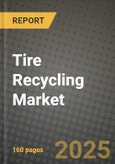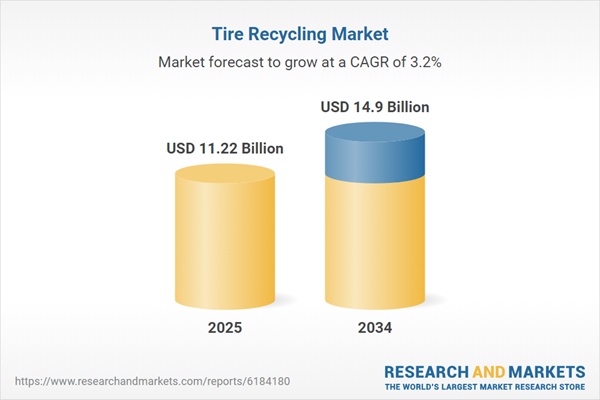Tire Recycling Market
The tire recycling market encompasses the collection, processing, and conversion of end-of-life tires (ELTs) into value-added materials, including crumb rubber, rubber granules, steel scrap, pyrolysis oil, recovered carbon black (rCB), and engineered rubber products. End-use applications span road and infrastructure (rubber-modified asphalt), molded rubber goods, construction materials, playground and athletic surfaces, industrial mats, automotive components, rubberized insulation, and emerging feedstocks for circular chemical and fuel pathways. The sector is driven by regulatory mandates discouraging tire landfilling and burning, along with sustainability goals emphasizing circular economy models and carbon footprint reduction. Technological progress is reshaping operations - from mechanical shredding and ambient/cryo grinding to advanced pyrolysis systems with upgraded condensers and char refining for higher-grade rCB. The market is influenced by extended producer responsibility (EPR) systems, waste tire collection frameworks, and incentives for recycled material inclusion in infrastructure and construction projects. Competitive dynamics include specialized recyclers, integrated waste management firms, and technology developers promoting modular and energy-efficient pyrolysis units. Profitability hinges on feedstock sourcing reliability, process energy efficiency, product quality consistency, and proximity to end-use industries. Challenges include variability in ELT availability, fluctuation in crude oil and virgin carbon black prices, environmental permitting complexity, and the need for standardized rCB performance specifications. Opportunities are strengthened by increased government funding for sustainable roads, OEM interest in circular rubber materials, and the transition toward industrial-scale pyrolysis with downstream purification systems.Tire Recycling Market Key Insights
- Shift Toward Circular Tire Materials
- Pyrolysis Commercialization and Scaling
- Crumb Rubber Demand in Infrastructure
- Athletic Surfaces and Safety Standards
- Regulatory and EPR Program Evolution
- Recovered Carbon Black Standardization
- Supply Chain and Logistics Optimization
- Energy Efficiency and Emissions Control
- Product Diversification for Margin Defense
- Investment and M&A Landscape
Tire Recycling Market Reginal Analysis
North America
Strong regulatory frameworks, active EPR systems, and infrastructure investments support large-scale crumb rubber and asphalt modification programs. Pyrolysis facilities are expanding, backed by OEM sustainability commitments and state-level recycling incentives. Logistics networks and regional plant clustering influence competitiveness.Europe
Strict landfill bans and advanced circular economy policy accelerate high-quality recycling and rCB development. European markets prioritize documented environmental performance, traceability, and standardized specifications. Investment favors energy-efficient pyrolysis and high-purity rCB refining, often integrated with regional compounders and rubber goods manufacturers.Asia-Pacific
High tire production and large vehicle populations drive significant ELT volumes. Markets vary widely in regulatory maturity; some regions emphasize TDF and material recovery, while others accelerate pyrolysis modernization. Infrastructure expansion and urbanization support rubberized asphalt adoption. Local cost advantages support scalable mechanical recycling.Middle East & Africa
Emerging recycling capacity is shaped by government initiatives targeting landfill reduction and import substitution. Climate-adapted roads and construction materials create opportunity for rubber-modified asphalt. Investment focuses on turnkey plants, technology transfers, and partnerships with international recyclers for skill-building and quality assurance.South & Central America
Regulatory frameworks are strengthening, with growing emphasis on integrated ELT collection networks. Demand is driven by road rehabilitation programs and expanding retail tire markets. Investment in crumb rubber plants is supported by public-private collaboration, while pyrolysis interest grows alongside fuel and rCB grade improvements.Tire Recycling Market Segmentation
By Type
- Service
- Material
By Product
- Rubber
- Tire-derived Fuel
- Tire-derived Aggregate
- Carbon Black
- Liquid Crystal Polymers
- Others
By Process
- Mechanical Shredding
- Ambient Grinding
- Pyrolysis
- Devulcanization
- Others
By Application
- Automotive
- Construction
- Manufacturing
- Rubber & Plastics
- Others
Key Market players
Liberty Tire Recycling, GENAN Holding A/S, ResourceCo, GRP Ltd, Lehigh Technologies, Inc., Entech Inc., Emanuel Tire, LLC, BDS Tire Recycling, Contec, CRM, Tinna Rubber & Infrastructure Ltd, LD Carbon Co., Circtec, Tyre Recycling Solutions SA, Weibold GmbHTire Recycling Market Analytics
The report employs rigorous tools, including Porter’s Five Forces, value chain mapping, and scenario-based modelling, to assess supply-demand dynamics. Cross-sector influences from parent, derived, and substitute markets are evaluated to identify risks and opportunities. Trade and pricing analytics provide an up-to-date view of international flows, including leading exporters, importers, and regional price trends.Macroeconomic indicators, policy frameworks such as carbon pricing and energy security strategies, and evolving consumer behaviour are considered in forecasting scenarios. Recent deal flows, partnerships, and technology innovations are incorporated to assess their impact on future market performance.
Tire Recycling Market Competitive Intelligence
The competitive landscape is mapped through proprietary frameworks, profiling leading companies with details on business models, product portfolios, financial performance, and strategic initiatives. Key developments such as mergers & acquisitions, technology collaborations, investment inflows, and regional expansions are analyzed for their competitive impact. The report also identifies emerging players and innovative startups contributing to market disruption.Regional insights highlight the most promising investment destinations, regulatory landscapes, and evolving partnerships across energy and industrial corridors.
Countries Covered
- North America - Tire Recycling market data and outlook to 2034
- United States
- Canada
- Mexico
- Europe - Tire Recycling market data and outlook to 2034
- Germany
- United Kingdom
- France
- Italy
- Spain
- BeNeLux
- Russia
- Sweden
- Asia-Pacific - Tire Recycling market data and outlook to 2034
- China
- Japan
- India
- South Korea
- Australia
- Indonesia
- Malaysia
- Vietnam
- Middle East and Africa - Tire Recycling market data and outlook to 2034
- Saudi Arabia
- South Africa
- Iran
- UAE
- Egypt
- South and Central America - Tire Recycling market data and outlook to 2034
- Brazil
- Argentina
- Chile
- Peru
Research Methodology
This study combines primary inputs from industry experts across the Tire Recycling value chain with secondary data from associations, government publications, trade databases, and company disclosures. Proprietary modeling techniques, including data triangulation, statistical correlation, and scenario planning, are applied to deliver reliable market sizing and forecasting.Key Questions Addressed
- What is the current and forecast market size of the Tire Recycling industry at global, regional, and country levels?
- Which types, applications, and technologies present the highest growth potential?
- How are supply chains adapting to geopolitical and economic shocks?
- What role do policy frameworks, trade flows, and sustainability targets play in shaping demand?
- Who are the leading players, and how are their strategies evolving in the face of global uncertainty?
- Which regional “hotspots” and customer segments will outpace the market, and what go-to-market and partnership models best support entry and expansion?
- Where are the most investable opportunities - across technology roadmaps, sustainability-linked innovation, and M&A - and what is the best segment to invest over the next 3-5 years?
Your Key Takeaways from the Tire Recycling Market Report
- Global Tire Recycling market size and growth projections (CAGR), 2024-2034
- Impact of Russia-Ukraine, Israel-Palestine, and Hamas conflicts on Tire Recycling trade, costs, and supply chains
- Tire Recycling market size, share, and outlook across 5 regions and 27 countries, 2023-2034
- Tire Recycling market size, CAGR, and market share of key products, applications, and end-user verticals, 2023-2034
- Short- and long-term Tire Recycling market trends, drivers, restraints, and opportunities
- Porter’s Five Forces analysis, technological developments, and Tire Recycling supply chain analysis
- Tire Recycling trade analysis, Tire Recycling market price analysis, and Tire Recycling supply/demand dynamics
- Profiles of 5 leading companies - overview, key strategies, financials, and products
- Latest Tire Recycling market news and developments
Additional Support
With the purchase of this report, you will receive:- An updated PDF report and an MS Excel data workbook containing all market tables and figures for easy analysis.
- 7-day post-sale analyst support for clarifications and in-scope supplementary data, ensuring the deliverable aligns precisely with your requirements.
- Complimentary report update to incorporate the latest available data and the impact of recent market developments.
This product will be delivered within 1-3 business days.
Table of Contents
Companies Mentioned
- Liberty Tire Recycling
- GENAN Holding A/S
- ResourceCo
- GRP Ltd.
- Lehigh Technologies Inc.
- Entech Inc.
- Emanuel Tire LLC
- BDS Tire Recycling
- Contec
- CRM
- Tinna Rubber & Infrastructure Ltd.
- LD Carbon Co.
- Circtec
- Tyre Recycling Solutions SA
- Weibold GmbH
Table Information
| Report Attribute | Details |
|---|---|
| No. of Pages | 160 |
| Published | November 2025 |
| Forecast Period | 2025 - 2034 |
| Estimated Market Value ( USD | $ 11.22 Billion |
| Forecasted Market Value ( USD | $ 14.9 Billion |
| Compound Annual Growth Rate | 3.2% |
| Regions Covered | Global |
| No. of Companies Mentioned | 15 |









